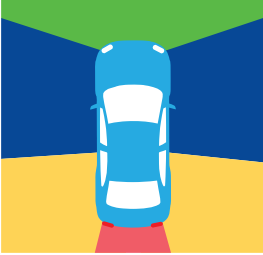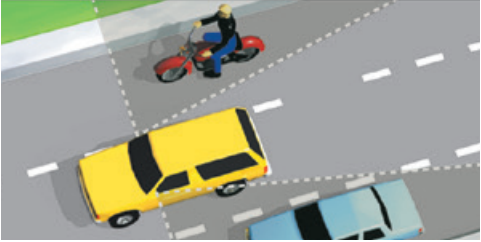
To drive safely, you need to know what is around you. This helps you make good decisions and react to hazards on the road. This image shows the areas around your vehicle.

To give yourself time to react, avoid last minute moves and hazards, always keep your eyes moving and scan the road at least 10 seconds ahead of your vehicle.
Tailgating makes it harder for you to see the road ahead because the vehicle in front of you blocks your view. You will not have enough time to react if the driver in front of you brakes suddenly. Use the three-second rule to ensure a safe following distance and avoid a collision. Following other vehicles at a safe distance gives you enough time to react if another driver makes a mistake.
If a vehicle merges in front of you too closely, take your foot off the accelerator. This creates space between you and the vehicle ahead.
Create more space in front of your vehicle when:
Be aware of what is on each side of you. To maintain enough space to
maneuver safely and react to other drivers:
Every vehicle has blind spots. These are areas around the vehicle that a driver cannot see when looking straight ahead or using the mirrors. For most vehicles, the blinds spots are at the sides, slightly behind the driver.
To check your blind spots, look over your right and left shoulders out of your side windows. Only turn your head when you look. Do not turn your whole body or steering wheel. Check your blind spots before you:

Knowing what is behind you can help you avoid rear-end collisions. Check traffic behind you often by using your rearview mirror, side mirrors, and turning your head when you:
When driving at night, use your high-beam headlights on open country roads or dark city streets. Make sure you can stop in the distance lit by your headlights. Do not use high-beam headlights in areas where they are illegal. Dim your high-beam headlights to avoid blinding the driver of an oncoming vehicle. If another vehicle’s lights are too bright:
When it is raining, use your low-beam headlights. Do not drive using only your parking lights. When you drive at night, remember:
To help manage sun glare:
A skid is when one or more of the tires lose traction with the road and the vehicle starts to slip. You may not be able to control your vehicle. There are a few different types of skids.
Ice and packed snow on the road can cause your vehicle to skid. This is even more likely if you are driving too fast or going downhill. Drive slowly and leave space between your vehicle and the vehicle ahead of you. To prevent skidding on slippery surfaces:
If you start to skid, follow these steps:
A locked wheel skid is usually caused by braking too hard when you are going too fast. If this happens, your vehicle will skid no matter which way the steering wheel is turned. To get out of a locked wheel skid if your vehicle is equipped with:
To determine if your vehicle has ABS, refer to the vehicle owner’s manual.
If your vehicle is not equipped with ABS and begins to skid, quickly pump your brakes until you are at a safe speed. If you:
If your brakes get wet, you can dry them by lightly pressing the accelerator and brake pedals at the same time. Only do this until the brakes dry.
Rain, snow, or mud can make the roads slippery. Drive more slowly than you would on a dry road. Adjust your speed for different conditions:
Some road surfaces are more slippery than others when wet. These usually have warning signs posted. Here are situations where the road may be more slippery:
Slow down at the first sign of rain, drizzle, or snow on the road. This is especially true if it has been dry and hot for some time, because oil and dust on the road’s surface have not been washed away.
Turn on your windshield wipers, low-beam headlights, and defroster. In a heavy rainstorm or snowstorm, you may not be able to see more than 100 feet in front of your vehicle. If you cannot see farther than 100 feet, it is not safe to drive faster than 30 mph. You may have to stop from time to time to wipe mud or snow off your windshield, headlights, and taillights. If you drive in snowy areas, carry snow chains for your tires. Snow chains give your tires more traction. Carry the correct number and type of chains for your vehicle.
Hydroplaning occurs when driving in wet or rainy conditions. Hydroplaning is a vehicle riding on water because the tires lose all contact with the road. A slight change of direction, applying the brakes, or a gust of wind could throw the vehicle into a skid. To avoid hydroplaning:
If your vehicle starts to hydroplane:
If stuck in the snow or mud, follow these steps:
Excessive water on a road may cause flooding. This can happen gradually or suddenly. It is important to understand the dangers of water on the road, including:
It may not be possible to determine the depth of the flood by looking. If the water is deep, the road may be too dangerous to cross. It is best to find another route. If you have no other option but to drive through a flooded road, drive slowly. After you make it through the water, test your brakes to make sure they work correctly.
High winds can be a hazard while driving. This is especially true for larger vehicles such as trucks, campers, and vehicles with trailers. When driving in high winds:
It is best to avoid driving in heavy fog or smoke. Consider postponing your trip until the fog clears. If you must drive in heavy fog or smoke:
If the fog becomes too thick to drive safely, consider pulling off the road. Activate your emergency flashers and wait for conditions to improve.
During a traffic break, the officer turns on their emergency lights and slowly weaves across lanes. Law enforcement uses traffic breaks to: